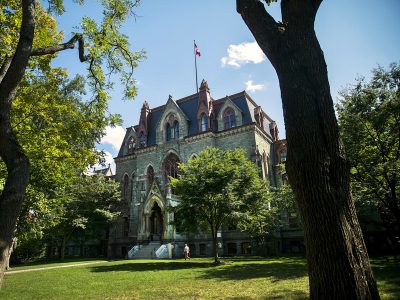
When Bari Spielfogel EAS’06 was 16, Duracell sponsored a contest at her Long Island high school to find the best student idea based on battery power. Spielfogel decided to focus on a problem that was receiving a lot of media attention—sleeping children accidentally left on school buses.
Her solution was Busguard, a device that uses infrared beams and a counter system to determine the number of people entering and exiting a school bus [“2006: A Penn Odyssey,” Nov/Dec 2002]. The first prototype won the Duracell contest—and an entrepreneur was born. But when Spielfogel arrived at Penn, where she’s enrolled in the School of Engineering and Applied Science, she couldn’t find the time, space, or guidance to push her project forward. That is, until she learned about the Weiss Tech House, Penn’s newly formed technology hub, created to promote undergraduate innovation and commercial development of new technologies. Spielfogel applied to the Weiss Tech House Innovation Fund committee last spring, and Busguard was back in business.
After operating for a year out of a cubicle in Huntsman Hall, Weiss Tech now has a permanent home—dedicated in October—at 3340 Walnut Street.
“There are a lot of students at Penn with a lot of great ideas,” Weiss Tech House student director Dwaune Dupree W’04 says. “But by the time they are juniors and seniors, the ideas die down, because they don’t really get the support they need to make them happen. But now, the Weiss Tech House is giving students that support.”
The idea for the innovation hub developed out of a conversation between William Hamilton, Jerome Fisher Management and Technology Program Director, and Penn trustee George Weiss W’65. They were discussing how to better foster the spirit of innovation promoted by the Management and Technology program—a degree program jointly offered by the Wharton and Engineering schools—more widely, harnessing all students’ appetites for innovation and giving them the resources to develop ideas. Weiss loved the concept. With a $1.5 million gift from Weiss, Hamilton enlisted Dr. Karl Ulrich, professor of operations information management, as the project’s faculty director and Anne Stamer G’97 as director. “What the Weiss Tech House is about is not just tolerating innovation by undergrads, but in fact we foster, encourage, and support it,” said Ulrich at the House opening on October 23.
With a variety of student-guided programs—and the organization of a multitude of resources across campus—the House does just that. Participants can work on community service projects or as technological consultants to organizations such as the Kelly Writers House. Students from any University school are encouraged to seek a technological mentor or tap the House for intellectual property advice.
In addition, all are welcome to simply take advantage of special events, including finely catered dinners with successful inventors. “The best thing is that the Weiss Tech House brings you a lot of options you didn’t know were available,” says Adnan Aziz EAS ’05. “It connects you with a much larger network of entrepreneurs who can give you advice and guidance.”
When Weiss Tech House officially opened the doors to its new home in front of 150 onlookers, including President Judith Rodin and Pennsylvania Governor Ed Rendell C’65 Hon’00, Innovation Fund projects such as Busguard and Clothes Dryer—a more energy efficient utility inspired by the poor dryer in creator Paul Silberschatz’s EAS’04 Delta Upsilon fraternity house—were on display.
The Innovation Fund offers students up to $1,000 in supplies and lab space to develop an accepted project. In Spring 2003, in the House’s first semester of operation, 28 applications were submitted. Last fall, another 20 filtered into the House. Now, with its doors open, Weiss Tech houses chaotic areas of technological development for dozens of initiatives.
Aziz, whose Artisense company is based on commercializing applications of an “edible flavored art-medium technology,” gained a private meeting with John Osher, inventor of the Crest Spin Brush, as a result of the Weiss Tech House “intimate dinner” program. Osher responded to Aziz’s vision that kids should be able to enjoy flavored greeting cards, and the two immediately began discussing methods of commercialization and licensing. Osher arranged a meeting for Aziz with one of the country’s largest greeting card manufacturers. The conversation has led to a potential licensing arrangement.
Industry contacts also have increased the commercial viability of another student project: Sameer Gupta’s Smiling Screens, a company focused on making computers simpler to use, particularly for senior citizens. Gupta W’03 EAS’04, one of the Innovation Fund committee’s founding members, and partners Scott Stein EAS’03 W’03 and Jason Zamer C’03, needed direction, resources, and connections, more than money.
Smiling Screens’ Simple C software package was well into late-stage development when accepted by the Innovation Fund. “Initially, the company and the idea of the company—with three Penn students working on it—didn’t receive that much respect,” Gupta says. “But once it became a Weiss Tech House project, that increased our credibility and our weight in any conversation.” Smiling Screens was set to launch its product at press-time.
House Projects, mentoring, and summer internship programs also serve Weiss Tech’s mission. “Many of the people at Penn that are inclined to start companies already have that entrepreneurial tendency,” Silberschatz says. “What the Tech House really does is give students who don’t want to start companies some exposure to technology and it helps them think about innovation in a practical way.”
“My greatest aspiration would be for people across the country to know about the Weiss Tech House,” Stamer says. “And that knowledge would benefit the students both educationally and by providing them with a network of mentoring services and resources well beyond their experiences at Penn.” It’s well on its way.
—Kent Malmros C’00




